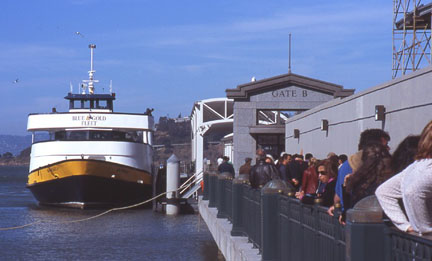It was a long, hard slog, and victory was only possible due to the stalwart support of Ferry Champion Senator Don Perata, but with passage of SB916, which puts to a vote of the people whether to raise bridge tolls, plans for improved and expanded ferry service figure to be in the money. With polls showing voters well-inclined to the toll-boost proposal, millions may be available for as soon as mid next year

Published: November, 2003
On October 10, 2003, Governor Davis signed Senate Bill (SB) 915 (D-Perata, Oakland) giving the WTA the green light to develop seven new Bay Area ferry routes, expand existing ferry routes, and build 31 new boats. SB 915 authorizes the WTA to operate a comprehensive San Francisco Bay area regional public water transit system.
"We are on the brink of a new and exciting future for ferries on San Francisco Bay. The State’s approval is a significant step towards delivering more boats, new routes and good landside connections," said Charlene Haught Johnson, President, WTA Board of Directors. "We thank the Governor and Legislature, especially the leadership of Senators Perata and Burton. This new law brings to fruition the work of hundreds of people who’ve advocated for enhancing our region’s public transit system with water transit," added Ms. Johnson. "The approval of the Authority’s plan culminates two years of technical work and an exhaustive public participation process. We thank everyone who helped, including the WTA’s Community Advisory and Technical Advisory Committees, public agencies, elected officials, members of environmental organizations, existing ferry operators, and other transit agencies."
The WTA’s ten-year plan recommends new ferry routes to South San Francisco, Berkeley, Richmond, Treasure Island, Antioch-Martinez, Hercules, and Redwood City, and expansion of existing routes. The WTA will also study a route between the East Bay and the Peninsula, Port Sonoma and several future locations including Hunter’s Point and Moffett Field.
SB 915 sets new standards for the nation’s ferry industry. The WTA will use boats with advanced emissions controls that will result in air emissions 85 percent cleaner than EPA’s 2007 standards for diesel engines. At least one boat will run on biodiesel, a renewable fuel. The WTA already has received a federal grant to design a zero-emission fuel-cell ferry.
A key component of the WTA’s future work will be to plan and coordinate ferries in emergency situations. "Ferries have a history in the Bay Area and throughout the world of assisting with emergency transportation following natural or man made disasters," said Tom Bertken, the WTA’s Chief Executive Officer. The WTA will update the Region’s Ferry Contingency Plan, which includes assessing the availability of vessels and terminals for civilian evacuation and transport of safety personnel.
The WTA was created in 1999 by the California Legislature to produce a ten-year plan for the expansion of a ferry system and landside connections. The Plan is based on technical studies, which analyzed ridership forecasts, environmental impacts, cost-effectiveness and funding projections. The WTA’s Plan and studies are available at www.watertransit.org.
Governor Davis signed a companion bill, SB 916, also on October 10. It specifies a $3 billion transit spending plan to relieve congestion on Bay Area bridges and highways by funding rail, bus, ferry and other regional transit projects out of a proposed $1 increase on all state-owned bridge tolls. Voters in seven Bay Area counties will have a chance to decide on this bill when it appears on the March 2004 ballot as Regional Measure (RM) 2. If it is approved, two new ferry routes, Berkeley and South San Francisco, and two new boats for Oakland/Alameda service will be partially funded. The WTA will work with local cities in pursuing federal and local funding for the services that did not get funded in SB 916. Improvements to the San Francisco Port’s Downtown Ferry Terminal, the regional hub for ferry service, is expected to receive some funding from RM 2 and some supplemental funding from San Francisco’s county sales tax renewal slated for the November 2003 ballot.
"The State of California made a huge investment in studying how ferries can give Bay Area commuters and recreational visitors more transit options. The opportunity to build a water transit system for the region’s future is exiting. I’m pleased by all the hard work, top expertise and public participation that has gone into the WTA’s plan." Sen. Don Perata (D-Oakland)
"As a historian of California, I consider the planning for ferry service on San Francisco Bay currently underway at the San Francisco Bay Area Water Transit Authority to be the most significant transit planning of the decade. Thanks to the visionary and practical work of the Authority, water transit – as in times past – will once again integrate the Bay Area into a civil and sustaining environment." Dr. Kevin Star, State Librarian of California
" If we’re really going to be prepared for a disaster, we need to have a ferry system. One, because of its capacity to go where other systems can’t go, that would be broken and damaged, and two, because we need redundancy. Also, one of the best parts of this whole system is that [the WTA has] built in the connectivity. They haven’t said, we’re just going to only look at what we’re going to put on the water, they’re looking at how to make sure that the people reach their final destination."
Supervisor Cynthia Murray, Marin County
"Too many workers need to come from too far away from their homes to work [in the South Bay]. And the more options we can give them on how they commute here in a safe, economical, stress-free and lower polluting form of travel, the better we’re all going to be."
Carl Guardino, President and CEO, Silicon Valley Manufacturers Group



